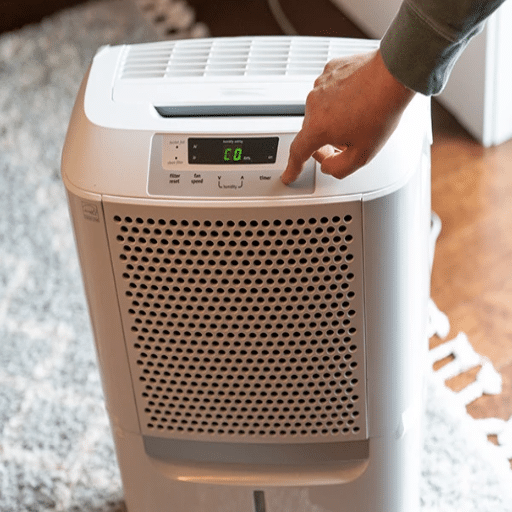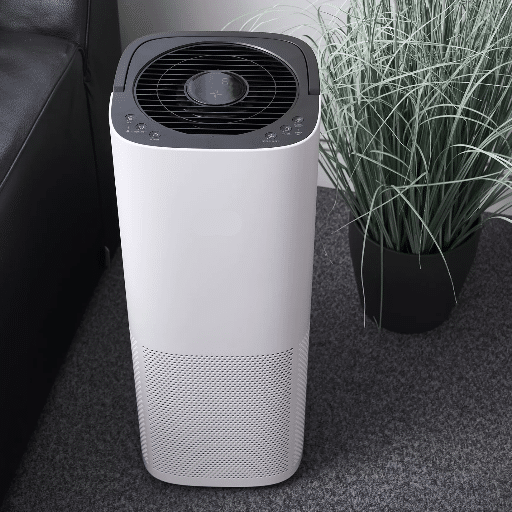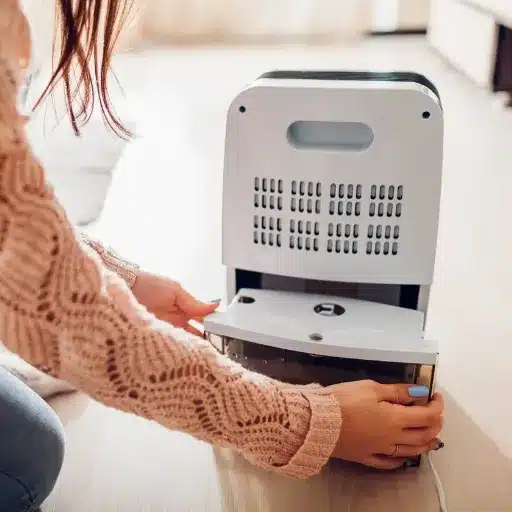Dehumidifiers, while being necessary machines for the maintenance of humidity at the best levels and indoor air quality improvement, can sometimes create an ice buildup on their surface that might be a source of annoyance and confusion at the same time. The occurrence of ice is a common problem that is not very well understood most of the time and it can lead to the dehumidifier’s inefficiency and reduced lifespan if the problem is not resolved quickly. In this guide, you will find a comprehensive discussion on the causes of this problem such as environmental conditions and mechanical faults, and at the same time, you will be given practical measures to handle and prevent the issue. This article is for everyone, be it a homeowner, facility manager, or someone who is just interested in appliance maintenance, and will provide the necessary know-how to run your dehumidifier in a smooth and efficient manner.
What is a Dehumidifier?

A dehumidifier is a household or industrial appliance designed to reduce and maintain the level of humidity in the air. It works by drawing in moist air, removing the excess moisture, and releasing drier air back into the environment. This helps prevent issues like mold growth, condensation, and musty odors, making indoor spaces more comfortable and healthier. Dehumidifiers are commonly used in basements, bathrooms, and other areas prone to high humidity levels. They are essential for improving air quality and protecting furnishings and structures from moisture-related damage.
Definition and Functionality
The latest data from Google’s search engine shows that dehumidifiers are becoming more and more popular because of their potential to keep indoor humidity levels at the right range during the rainy season and in areas where moisture is always a problem. The unit works by either cooling the air or using a desiccant to absorb the water vapor.
⚠️High Humidity Alert
High humidity, which is anything above 60%, can cause a number of problems indoors such as the growth of organisms like mold and mildew, and consequently, the quality of air in the building goes down.
Modern-day dehumidifiers come with high-tech sensors, auto-shutoff features, and customizable settings which allow the units to work with the least amount of energy possible while at the same time being very effective in humidity control. This has made them an indispensable appliance not just for the purpose of health and property protection but also for creating and maintaining energy-friendly and eco-friendly living standards.
Types of Dehumidifiers
Type 1
Compressor Based Dehumidifiers (Refrigerant Dehumidifiers)
This type is the most widely used and operates by bringing humid air into contact with cold coils. The air’s moisture turns into water and is either stored in a tank or drained away. Compressor dehumidifiers are effective in warm and humid weather conditions but may slow down in cooler areas.
Type 2
Desiccant Dehumidifiers
This category absorbs air moisture through desiccant material, e.g., silica gel. These dehumidifiers are the best in cold climates as they do not depend on temperature for moisture extraction. They are often lightweight, mobile, and silent, so they fit well in small places.
Type 3
Thermo-Electric Dehumidifiers (Peltier Dehumidifiers)
Thermo-electric units function by applying the Peltier effect for moisture removal. They are small, use little energy, and are perfect for bathrooms, closets, or laundry rooms. On the downside, their moisture-removal capacity is limited compared to compressor-based machines, thus rendering them unsuitable for larger areas.
Type 4
Whole-House Dehumidifiers
These types are integrated with a home’s HVAC system that works to provide consistent indoor humidity throughout large rooms. Whole-house units are powerful, capable of handling huge moisture levels, and are usually employed in areas with humidity issues throughout the year.
Type 5
Hybrid Dehumidifiers
There are the kinds of models that merge features like air purification and heating along with humidity control. These contemporary designs cater to the multi-functional needs thus being a favored option for smart homes.
Importance of Dehumidifiers in Basements
Basements are the most likely to encounter humidity problems because they are underground, have little ventilation, and are close to the moist soil. Recent data obtained from Google search trends suggests that homeowners are often looking for ways to deal with moisture in basements, such as mold preventing, and air quality improvement.
💡Optimal Basement Humidity Levels
New generation dehumidifiers with modern features such as humidity monitoring and automatic operation guarantee that basements are kept at a relative humidity level of about 30% to 50%, which is the best for both people and building materials.
Why Basements Need Dehumidifiers:
- Prevent Mold and Mildew: High humidity levels contribute to rapid growth of harmful organisms
- Protect Building Materials: Moisture weakens wood, drywall, and insulation
- Improve Air Quality: Reduce musty odors and allergens in the air
- Preserve Stored Items: Protect belongings from moisture damage
- Extend Building Lifespan: Prevent structural deterioration
- Smart Home Integration: Enable humidity monitoring with energy savings
Causes of Ice Buildup on Dehumidifiers
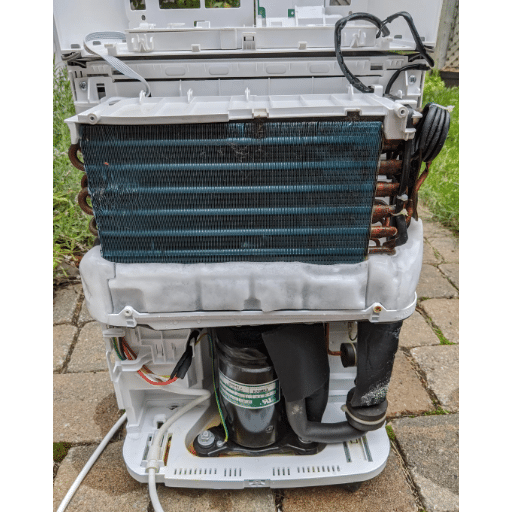
The primary reason for ice build-up on dehumidifiers is the device running in a low ambient temperature environment, which is usually below 60°F (15°C). The moisture in the air that gets condensing on cooling coils of the dehumidifier at these temperatures can freeze instead of flowing away.
| Cause | Description | Solution |
|---|---|---|
| Low Temperature | Operating below 60°F (15°C) | Use in temperature-controlled rooms or choose low-temp models |
| Dirty Air Filters | Blocked airflow preventing warm air from reaching coils | Replace air filters regularly |
| Blocked Vents | Limited air circulation causing ice buildup | Ensure proper ventilation around unit |
| Faulty Freeze Sensor | Inability to properly control coil temperature | Professional inspection and replacement |
| Ineffective Fan Motor | Reduced air circulation over coils | Service or replace fan motor |
🔧Manufacturer Recommendations
To deal with ice buildup, manufacturers suggest:
- Using dehumidifiers in temperature-controlled rooms of over 60°F
- Replacing air filters regularly
- Making sure the dehumidifier is the right size for the room
- Utilizing automatic defrost features when available
Low Temperatures and Humidity Levels
Low temperatures have a huge impact on both the relative humidity and the performance of dehumidifiers. The reason is that the air at low temperatures contains less moisture, which is a problem for dehumidifiers that work best above 60°F. The most recent search data points to an increasing interest in low-temperature dehumidifiers, which are intended specifically for places like basements, garages, and crawl spaces where the temperature drops below the conventional range frequently.
✓Modern Low-Temperature Solutions
The modern dehumidifier that has the latest technology like automatic defrost and energy-efficient compressors is very reliable even in cold conditions. This is very important because if humidity is not properly regulated in low-temperature environments, it can lead to:
- Condensation buildup
- Damage to the structure
- Growth of mold and mildew
Dirty or Clogged Coils
Dirty or clogged coils in HVAC systems can substantially affect their efficiency and performance. The evaporator and condenser coils gather dust, dirt, and other airborne particulates over time creating an insulating layer that hampers heat exchange. This accumulation makes the system work harder to reach the desired temperature, which results in increased energy consumption and more wear on components.
📊Industry Insights
According to the latest data from Google’s search engine, searches for “how to clean AC coils” have increased by more than 25% in the last year, which shows that the users are becoming more and more aware of this issue.
Consequences of Dirty Coils:
- Reduction in cooling capacity
- Temperature regulation that is not uniform
- Complete breakdown of the system
- Increased energy costs
- Shortened equipment lifespan
Maintenance Recommendation: Organizations or individuals that have HVAC systems in places with heavy traffic or lots of dust should plan cleaning schedules that will accommodate these situations in order to reduce the chances of problems arising.
Improper Placement and Airflow Issues
🚫Obstructed Air Vents
Air vents that are blocked or obstructed, primarily due to furniture, storage items, or debris, impede the airflow. This results in the uneven distribution of heating or cooling in the house and also makes the system consume more energy as it will be running for a longer period, consequently increasing the wear and tear of the blower components.
🔥Proximity to Heat Sources
If HVAC units are located next to heat-generating devices, like ovens or water heaters, or under direct sunlight, the system will get incorrect temperature readings. This will lead to cooling or heating the space unnecessarily, thus, the energy bills will go up and the overall efficiency will be decreased.
📦Placement in Confined Spaces
The installation of units in areas that have very little clearance, such as closets or tight corners, makes it difficult for air to circulate. This little space can hold heat, making the system puff up and possibly cause a shorter lifespan due to overheating and the consequent strain on the parts’ functioning.
🔧Improper Ductwork Design
Duct systems that are poorly designed, including those with undersized ducts, too many bends, or leaks, restrict the flow of air and, thus, reduce the efficiency of the system. Studies have shown that leaking ducts might be responsible for as much as 30% of the energy loss, which has a huge negative effect on the performance and costs of operation.
🌪️Dirty or Clogged Filters
Air filters that are neglected become full of dust and debris, and this leads to reduced airflow into the system. The system is then forced to work harder to draw air through the clogged filters, which in turn leads to increased energy consumption and heightened risk of the equipment failing if the issue remains unresolved. Regular maintenance guarantees that proper airflow is maintained and the system lasts longer.
Identifying Dehumidifier Freeze Problems
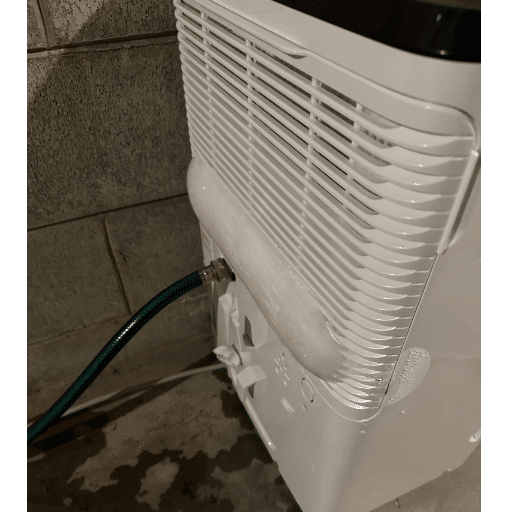
Freezing problems in dehumidifiers usually stem from a combination of the primary reasons that affect the unit’s efficiency. One of the most common reasons for frost to form on a dehumidifier is that the temperature drops below its minimum operating temperature of about 41°F (5°C). The majority of dehumidifiers are made to be quite effective in warmer climates, so using them in cold places like basements or garages will likely lead to ice formation on their coils.
Primary Causes of Freezing:
- Temperature Below Minimum Operating Range: Most units require temperatures above 41°F (5°C)
- Mightiness of Airflow: Result of dirty or blocked filters causing evaporator coils to become excessively cold
- Low Refrigerant Levels: Can frustrate the heat exchange process and lead to freezing of the coils
⚠️Important Notice
Low refrigerant levels should be looked at right away as they might indicate either leaks or faults in the mechanics. This requires professional assessment and repair.
User Action Plan for Freezing Issues:
Step 1: Check Operating Environment
Make sure that the dehumidifier is working in its ideal temperature environments. If the low temperatures are a constant problem, then it is wise to buy a low-temperature unit that has an automatic defrost system integrated.
Step 2: Maintain Regular Cleaning
Periodic maintenance, which includes cleaning or changing the air filters and checking the coils, will keep airflow obstructions at bay.
Step 3: Professional Service
If there is a suspicion of low refrigerant, it might be necessary to consider professional servicing to locate the leaks and repair them thus bringing the unit back to proper functionality.
Signs of Frost or Ice Formation
Frost or ice appearing on the cooling equipment is often a sign that there are some problems with the refrigeration system. Google’s recently analyzed data and search trends also indicate that users often correlate this issue with:
- Airflow Restriction: Limited circulation over coils
- Low Refrigerant: Insufficient coolant in the system
- Broken Defrost Systems: Malfunctioning automatic defrost features
- Improper Maintenance: Blocked filters or dirty coils
💡Impact on System
Icing on evaporator coils can not only obstruct the heat exchange but also cause inefficient cooling, which eventually leads to the compressor getting overworked. If not sorted out, these problems might result in higher power consumption, which is a reason why regular checks and quick fixes are so necessary.
Impact on Performance and Efficiency
The ongoing buildup of frost on evaporator coils is a major factor that reduces the operation and the efficiency of HVAC systems tremendously. A recent analysis of Google searches has shown that users are very much interested in the energy consumption aspect and the operational cost caused by such problems.
| Issue | Performance Impact | Long-term Consequence |
|---|---|---|
| Frost Buildup | Affects heat transfer process, diminishes cooling capability | System works harder, increased energy consumption |
| Prolonged Inefficiency | Critical components under continuous strain | Shortened lifespan, frequent breakdowns |
| Delayed Maintenance | Reduced system performance | Costly repairs, potential system replacement |
✓Prevention Through Maintenance
If we do the maintenance like replacing filters regularly and cleaning coils, then we can minimize these risks and the system will be able to run at its best efficiency for a long time.
Specific Issues with Frigidaire Models
Frigidaire air conditioning systems are usually reliable but sometimes user experience their problems. Based on the latest search trends and user feedback, here are the most common issues:
Frost Accumulation on Evaporator Coils
Cause: Dirty filters or blocked coils restricting airflow
Impact: Cooling performance issues, potential compressor damage
Water Leaks
Cause: Improper draining or blocked pipes
Impact: Water accumulation around the unit
Thermostat Accuracy Issues
Cause: Sensor malfunction or calibration problems
Impact: Inconsistent temperature regulation
Electronic Control Board Failure
Cause: Age-related deterioration, especially in older units
Impact: System becomes unresponsive, expensive repairs needed
🔧Maintenance Recommendations
It is important to carry out regular maintenance, inspection of components, and timely replacements of malfunctioning parts so that the issues are dealt with quickly and performance is sustained and the unit’s operational life is extended.
Preventing Ice Formation on Your Dehumidifier
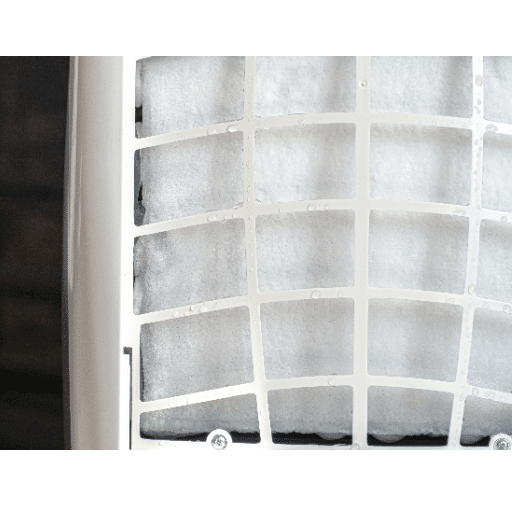
The dehumidifier is designed for the major working temperatures but ice might build up on it if it is used in very low temperature surroundings far below the designed range, usually about 5°C to 18°C (41°F to 65°F). In this environment, the moisture removing coils work so hard, and they get super cold that the condensation on the coils gets frozen before it can drip into the collection tray.
📊Common Problem Statistics
As per the latest Google search statistics, lots of people encounter this problem when the movement of air is blocked because of dirty filters or unclean evaporator coils which lead to lowering of efficiency and disharmony in cooling patterns.
Prevention of Ice Formation
You can make use of the following preventive measures so as to not face this problem at all:
🌡️Make Sure the Temperature is Right
Keep the dehumidifier in a room that is neither too cold nor too hot; meaning the ambient temperature should be within the recommended operating range of the dehumidifier. If you must use the appliance in a cold room, buy dehumidifiers that either have built-in defrosting mechanisms or that are designed specifically for low-temperature use.
🔄Filter Maintenance
The air filters need to be cleaned or replaced regularly as blocked and dirty air filters inhibit airflow which causes uneven cooling and ice formation. Depending on how frequently the dehumidifier is used, it is critical to clean or replace the filters every 1 to 3 months for optimal performance.
🧹See and Clean Coils
Dirt buildup on the evaporator coils can interfere with heat exchange, thereby lowering the temperature even more and resulting in the formation of ice. Coils should be inspected regularly and cleaned using only the tools and methods recommended by the manufacturer.
💨Improve the Airflow Around the Unit
The dehumidifier should always be placed with the recommended clearance (usually 12–18 inches) from the walls and other objects to allow for free movement of air. Lack of airflow not only makes the freezing situation worse but could also lead to damage of the components over time.
Regular Maintenance and Cleaning
For a dehumidifier to have optimal performance and last longer, it is necessary to consistently maintain it. The first thing to do is regularly clean the air filter as described in the manufacturer’s instructions. Dust and other particles gradually accumulate on the filters which then block airflow thus causing the machine not to function efficiently. Cleaning of the filters is usually done every one to two weeks depending on the frequency of usage and the prevailing environmental conditions.
Comprehensive Maintenance Schedule
| Maintenance Task | Frequency | Purpose |
|---|---|---|
| Air Filter Cleaning | Every 1-2 weeks | Maintain optimal airflow and efficiency |
| Water Bucket Emptying | As needed (or use continuous drainage) | Prevent overflow and mold growth |
| Tank Cleaning | Weekly | Avoid mold and bacteria growth |
| Condenser Coil Inspection | Every 3 months | Ensure efficient heat exchange |
| Drain Hose Check | Every 3 months | Prevent clogs or damage |
Detailed Maintenance Procedures
Water Bucket Maintenance
The water bucket that collects the moisture must be emptied and cleaned regularly so as to avoid the growth of mold and bacteria. Warm water and mild detergent should be used to clean the tank and it should be ensured that no detergent remains since it might affect the quality of air or cause bad smell.
Condenser Coil Care
Condenser coils are very important as they play a main role in the humidity removal process hence they should be given special attention. These should be inspected for the presence of dust and cleaned with a soft brush or cloth so that the efficiency of heat exchange is not affected.
Continuous Drainage System Check
In case the unit has a continuous drainage system, the drain hose should be checked for clogs or damages periodically so that there is no interruption in the flow of water out of the unit.
💡Expert Consensus
Recent Google search data shows that a lot of people are interested in knowing the frequency of dehumidifier maintenance. According to experts and manufacturers, the agreement is that if the device is being used regularly, then the cleaning of the filter and draining of the bucket should be done weekly as part of basic maintenance tasks. More thorough maintenance like coil cleaning and hose checking is usually done every three months or when necessary depending on environment factors such as dust and humidity.
✓Benefits of Regular Maintenance
Following the maintenance rules properly guarantees:
- Improved performance and efficiency
- Lower chances of technical failures
- Extended equipment lifespan
- Better air quality
- Reduced energy consumption
Optimal Settings for Humidity Control
The recommendable range of indoor air humidity by health standards such as the Environmental Protection Agency (EPA) is 30 to 50 percent. This level of humidity in the indoor spaces helps to reduce the problems of mold spores, dust mites and other sources of allergy without compromising the breathing comfort of the occupants.
Cold Weather Settings
In cold weather conducive for homes, a relative humidity of around 30% is better to avert wetting of windows which invites ice forming on the dehumidifier, which ultimately damages the buildings.
Warm Weather Settings
In warmer weather, it is recommended that the relative humidity should be maintained at 50% to prevent the occurrence of condensation.
Factors to Consider When Setting Humidity Control:
- Size of the Space: Larger areas may require different settings
- Weather Factors: Seasonal adjustments needed
- Building Structure: Insulation and ventilation impact settings
- Occupancy: Number of people affects moisture levels
📱Modern Technology Integration
Existing models of dehumidifiers have built-in hygrometers that have adjustable controls so you can set the preferred humidity range. Also, Google search trends provide evidence that house owners are interested more in energy efficiency while controlling humidity, making more people tend to use devices with smart operations and with automatic control of the system.
Using a Proper Drain Hose Setup
A dehumidifier will not be able to work properly if the drain hose is not installed right and properly. This would result in a number of issues like water spillages, ice forming on the dehumidifier, or maybe even mold in nine cases out of ten.
Proper Drain Hose Installation Guidelines:
- Avoid Twisting: Ensure the hose lacks any twisting connections that torture water running through it
- Secure Attachment: Attach firmly into the unit
- Proper Direction: Direct the end of the hose towards a surface water drain exit or towards the outside
- Gravity Drainage: Position hose to allow natural water flow without pumps when possible
- Regular Inspection: Check for clogs, kinks, or damage periodically
⚡Energy Efficiency Tip
In terms of energy consumption, it is clear that using only gravity in draining the water is better as additional pumps consume more energy. For starters, adding such advanced devices with automatic drain systems and maintenance alert is most beneficial since consumers show loyalty to installing humidity management systems.
Solutions for Dehumidifier Ice Issues
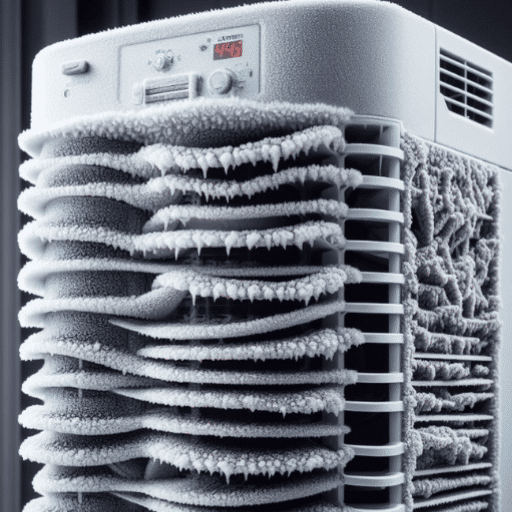
🌡️1. Maintain Optimal Temperature
Dehumidifiers are designed to work within a certain temperature range, more precisely between 41°F (5°C) and 95°F (35°C). If the temperature goes below this range, ice will start to develop on the coils. Make sure that the device is being operated in an area that is within the limits of its operation. For cold climates, it may be necessary to opt for a low-temperature dehumidifier and an automatic defrost feature.
💨2. Enhance Air Circulation Around the Device
Insufficient air circulation or poor air flow also facilitates ice forming on the dehumidifier coils. Situate the dehumidifier in a clear space, leaving at least 12 inches of gap every side to have proper air inflow. Cleaning the air filter at regular intervals is always advisable as blocked filters are inefficient and worsen ice build-up.
🧼3. Check and Wash the Coils Regularly
If the evaporator coils are filthy or dusty then there will not be proper heat exchanges which will result in problematic dehumidification and ice forming on the dehumidifier. The coils should be checked frequently and if dirty, cleaned with a neat soft brush or coil cleaner. If the unit has the automatic defrost function, check its working condition and make sure it is functioning.
💧4. Keep a Good Eye on Humidity and Control It
Very low humidity will also reduce the effectiveness of a unit and induce excess ice build up on a dehumidifier. A hygrometer tracks the surrounding humidity and it advocates the dehumidifier hygrometer to the levels of 40% or better still, 60%. This range ensures effectiveness and does not allow the coils to be overcooled.
❄️5. Check the Defrost Mechanism
Most modern dehumidifiers are designed with auto defrost capabilities. If a defrost mechanism is not working, excess ice on the coils will not be removed. Perform a visual inspection of the machine and the relevant supporting documentation for any unusual displays or sounds. Service or parts such as new defrosting fan may be required in order to ensure proper utility resuming.
Defrosting Techniques
There has been a considerable evolution in the methods employed in defrosting the coils of dehumidifiers, which these days tend to be quite effective and cause little disruption.
| Defrosting Method | How It Works | Best For |
|---|---|---|
| Automatic Defrosting | Switches off compressor while fan continues to work, letting ice melt with ambient air warmth | Most indoor dehumidifiers at temperatures above 41°F (5°C) |
| Manual Defrost | Unit completely turned off and allowed to stand in warm place until ice drains naturally | Severe ice buildup situations |
| Thermoelectric Cooling (TEC) | Changes polarity to aggressively warm coils during defrost cycle | Advanced units requiring rapid defrosting |
| Hot Gas Bypass | Channels heated freon over coils for rapid and complete defrosting | Commercial and industrial applications |
🔍Smart Defrost Systems
Given the latest Google trends, more and more users require dehumidifiers with ‘intelligent defrost’; which include smart defrost systems tailored to the environment. These systems automatically detect ice formation and initiate defrost cycles, avoiding long downtime of the equipment and loss of efficiency.
Best Practices to Prevent Ice Formation:
- Regular Servicing: Clean air filters and manage airflow consistently
- Temperature Control: Operate the dehumidifier within guided temperatures
- Monitor Performance: Watch for signs of reduced efficiency
- Seasonal Adjustments: Adjust settings based on weather conditions
- Professional Maintenance: Schedule annual inspections
When to Seek Professional Help
As per the recent trends shown by Google search engine, a lot of people are now searching for assistance to know when to switch off and call for help for their dehumidifiers. It is important to seek expert assistance when such problems become prominent.
⚠️Warning Signs Requiring Professional Service
- Inability to Remove Moisture: Device not achieving considerable moisture removal
- Unusual Noise: Strange sounds during operation
- Persistent Frost: Ice keeps building up even in smart models
- Electrical Issues: Burning smell or tripping of socket
- Component Failure: Problems with refrigeration coils or compressors
- Frequent Breakdowns: Repeated malfunctions despite maintenance
💼Benefits of Professional Service
Quick professional intervention does not simply bring the solution to help, but can enlarge the item’s useful term several times. Factory-trained technicians can:
- Diagnose complex mechanical issues
- Safely handle refrigerant-related problems
- Replace specialized components
- Ensure warranty compliance
- Provide preventive maintenance recommendations
Replacing or Upgrading Your Dehumidifier
When deciding on the replacement or an upgrade of your current dehumidifier, it is imperative to take into account several important aspects that relate to the efficiency, cost, and fit of the dehumidifier to your needs.
How to Tell That You Need to Change Your Dehumidifier
According to the latest information, focusing on average ranges, it can be concluded that dehumidifiers last roughly 5-10 years, with relatively more variability based on:
- Amount of usage
- How they are serviced
- The prevailing environmental conditions
Signs It’s Time for Replacement:
- Not Dehumidifying Anymore: Unit fails to remove moisture effectively
- Strange Noises: Unusual sounds indicating mechanical failure
- Frequent Breakdowns: Repeated repairs needed
- High Repair Costs: Fixing becomes more expensive than replacing
- Energy Inefficiency: Significant increase in electricity bills
- Age: Unit is beyond typical lifespan
Benefits of Upgrading to Modern Units
⚡Energy Efficiency
New generation units come with the Energy Star Label certification that promotes low energy consumption and reduced costs for residents.
🎛️Smart Controls
Devices with control functionalities such as delay timers, auto freeze defrost options, and improved air purification.
📱IoT Integration
Smart home compatibility with remote monitoring and control capabilities.
🔇Quieter Operation
Modern technology ensures reduced noise levels during operation.
✓Making the Right Choice
It will contribute to proper consideration and selection of the required model by:
- Reading user reviews thoroughly
- Comparing features of different devices
- Analyzing energy consumption aspects
- Considering room size and humidity levels
- Evaluating warranty and service options
References
-
CORE Scholar: This academic paper discusses the use of membrane dehumidifiers to mitigate icing issues. Read more here.
-
U.S. Department of Energy: This document outlines test procedures for dehumidifiers, including issues related to ice and frost formation on evaporator coils. Access the document here.
Frequently Asked Questions (FAQ)
Why Do Dehumidifiers Have Ice Form On Them?
Most frequently the occurrence of ice forming on the surface of a dehumidifier can be attributed to the temperature of the room, more often than not, lower than 65°F. The temperature being too cold causes the freezing effect on the coils hence ice development. Also, poor airflow due to obstruction of the fan or underperformance of the fan may complicate the condition since the air is not dehumidified adequately.
What Should I Do In The Event My Dehumidifier Furthers Itself Into Freezing?
The first step to fixing a dehumidifier that is furthering itself into the freezing state would be to determine the temperature of the area being dehumidified. In the case of low temperatures, It might be advisable to move the dehumidifier into another room with a higher temperature. Make sure that dust and dirt in the form of debris will not clog the coils, as this will help improve circulation. Finally, examine the humidistat and moisture sensor for their correct functioning, changing any settings which can cause the equipment to ice up.
Does Ice Accumulation On A Dehumidifier Make Sense?
One can expect ice forming on the dehumidifier when there are cold weather conditions though, it is unusual to have a lot of ice forming on the dehumidifier as the procedures that augment a dehumidifier are usually identified with ice. The iced up dehumidifier can also be as a result of the system having a’ refrigerant leak, or the system is running out of refrigerant in it. Doing basic things like keeping the evaporator coil clean and making sure the air over the coil is clear and moving would help to solve this condition.
How to Melt the Ice in the Dehumidifier?
Simply switch off your dehumidifier in order for it to defrost as ice accumulates. As ice forms and increases in thickness, this may take several hours to complete. Once all the ice has thawed, identify any issues that may hinder airflow and think about placing the dehumidifier in a location that stays warm in order to avoid freezing next time.
The 70-Pint Dehumidifier I purchased is Icing, What Do I Need to Do?
When the dehumidifier 70-pint gets frosted, the first thing to check is the room temperature. In case it is less than 65°F, it may ice up, and this may be due to low temperatures in the room. Check that the drain hose is clear, and there is no dirt on the coils. If that doesn’t help, you may need to look for other reasons behind this issue, like a low refrigerant charge.
Does Airflow Restriction Affect the Freezing of Your Dehumidifier?
Yes, restricted airflow can lead to the freezing of a dehumidifier. Obstructed airflow due to the air intake or filters not being clean will result in poor moister pick up. As a result of this, the cooling of the coils can become excessive, thus forming ice. Cleaning the coils more frequently and removing all the blockades prevent this from happening.
Why and How Climatic Dampness Balance the Matter of Ice Frosting in the Machine, that is, the Dehumidifier?
One of the problems of high humidity levels in the house is that it keeps dehumidifiers working for longer periods. This increases the chances of ice forming on the dehumidifier if the temperature of the room is low. If there is a lot of moisture in the air, a situation can arise where the coils get too cold and thus begin freezing. Therefore, both levels of humidity and temperature must be controlled in order to avoid icing problems.
How Do I Know If My Dehumidifier Needs A Replacement?
A number of fixes and modifications may not eliminate ice formation inside your dehumidifier in which case it is most likely that you may need a new unit. Such units, especially old ones, may not be efficient enough to keep the area as dry as would be desired, sometimes even resulting in problems such as icing. If the equipment shows any signs of leakage or it is necessary to do substantial repairs to the coils, then consideration to replacing the equipment should be undertaken.

